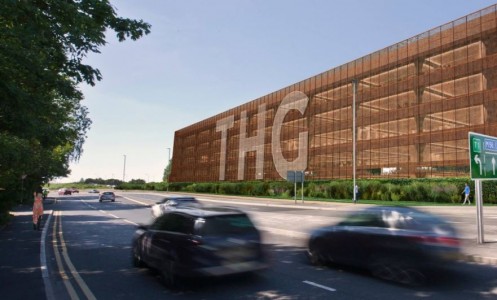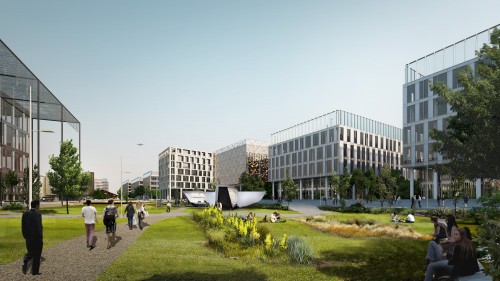
Green space, office, retail, hotels, and residential housing are part of the Airport City Manchester project, located adjacent to Mancester Airport in England (rendering courtesy Airport City Manchester)
By Ron Bernthal
With little fanfare and just modest media coverage, the total planning area of the Airport City Manchester project now comprises about five-million square-feet, with a total development value of over $1.3 billion. The project, situated next to Manchester, England’s busy internatinal, is one of the most connected, intelligent and enterprising business destinations in development today. The site encompasses office buildings, hotels, advanced manufacturing, logistics facilities, retail space, and d ybrid and ancillary retail space, hotels, retail space, along with transient and permanent residential units.
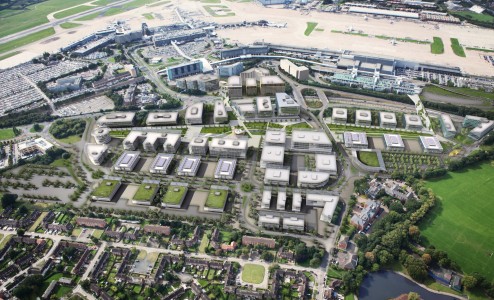
Aerial view of Airport City Manchester project with Manchester Airport shown at top of image. Multiple business campuses, hotels, logistics and manufacturing building, as well as access to rail lines and major highways (image courtesy Airport City Manchester)
The project is not only helping to expedite the airport’s own terminal’s expansion program (a separate project, using different funding), but the area surrounding Manchester Airport is now offering a very desirable lifestyle for business executives and employees who are relocating to the Manchester suburbs, with outstanding residential, education and leisure facilities.
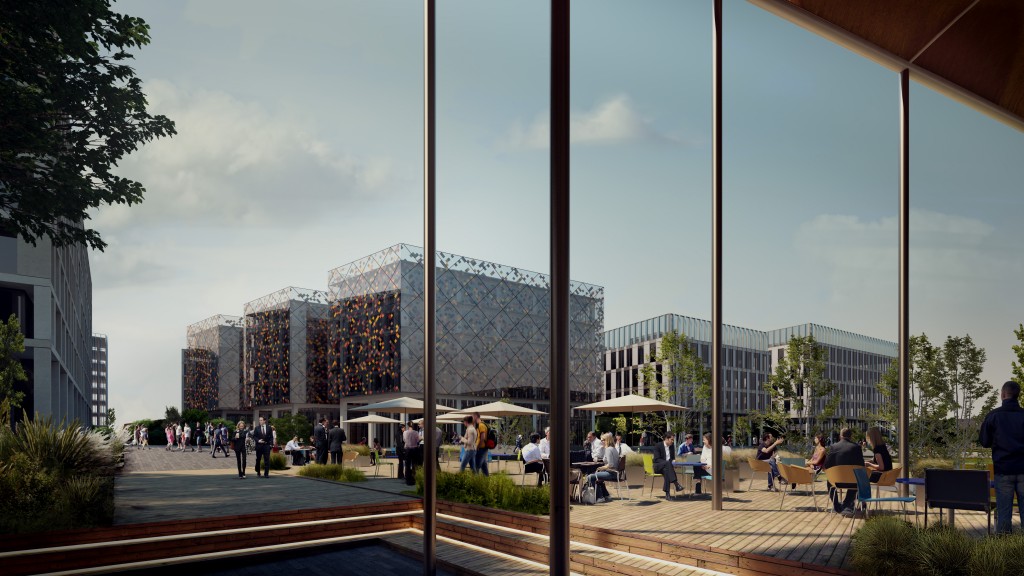
View of one of the business campuses being developed at Airport City Manchester, a new development project adjacent to Manchester Airport (rendering courtesy Airport City Manchester)
Adjacent to the UK’s third biggest airport, the largest of the two sites, ‘THQ’, is a new landmark business campus being developed by The Hut Group (THG), one of the world’s largest online retailers in beauty and nutrition with many lifestyle brands. The site will be built over 16.8 acres in four phases, with phase one comprising office buildings totalling 280,000 square-feet. Construction on the ‘THQ’ should be completed in 2022. At a second site nearby, THG is building a new development called ICON, the Group’s new content creation studio. Following THG’s acquisition and integration in 2017 of the UK’s leading content studio, Hangar 7, THG has acquired an 11.6-acre site in the Manchester Airport area.
The ICON development will provide an extra 104,000 square-feet of office space over four floors as well as additional content creation facilities totalling 168,000 square-feet, ICON will house 2,000 people who will focus on video production and photography, to be used across THG’s digital offering. THG already has a presence at Airport City after renting 79,000 square-feet of office space in the Voyager and 4M buildings earlier this year. In total, THG now has about 1,000 staff that are currently based at their Airport City Manchester sites. The $1.3 billion development over the firm’s two sites at Airport City Manchester is the UK’s biggest ever bespoke office project outside of London.
A significant milestone at Airport City Manchester was reached in spring, 2020, as its landmark pedestrian and cycle bridge, 312-feet long, was installed over the M56 spur airport approach road. This latest piece of infrastructure took 12 hours to install, and is a striking addition to the landscape at Airport City Manchester. Featuring more than 21,000 perforations across its length, it was constructed from Cor-Ten steel which develops a rust-like aesthetic after several years’ exposure to weather and eliminates the need for painting.
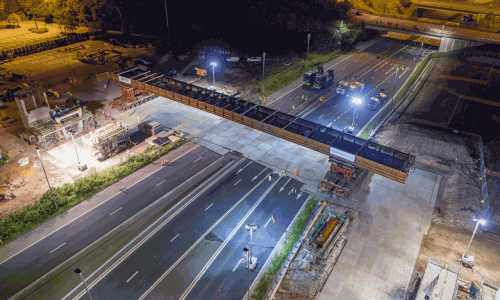
View of new pedestrian and biking bridge that provides access to Airport City Manchester locations (rendering courtesy Airport City Manchester)
The pedestrian and cycle bridge, partly funded by the Manchester City Council, will deliver a sustainable connection from the Airport City Manchester site directly to rail, bus and tram links, as well as providing direct access to pedestrians and bicyclists travelling to and from Wythenshawe and surrounding areas.The bridge, possbily the only exclusively pedestrian/bike aiport bridge in the world, is expected to open in late 2020.
The brand new bridge at Airport City Manchester will blend into the neighboring buildings with extensive landscaping, as well as providing ramps and passenger lifts to elevators it is accessible to all. “This bridge is a landmark in the development of Airport City Manchester, which will link Wythenshawe people with the jobs and opportunities being created there,” said Sir Richard Leese, leader of the Manchester City Council. It’s a symbol of that connection as well as another boost to walking and cycling facilities in the city.”
Work on Airport City’s new $234 million hotel district is also progressing, where three new hotels with 1,500 new rooms, will open by 2022, including a 280-room Holiday Inn and a 262-room Ibis Budget to be located immediately adjacent to Terminal 2 at Manchester Airport.
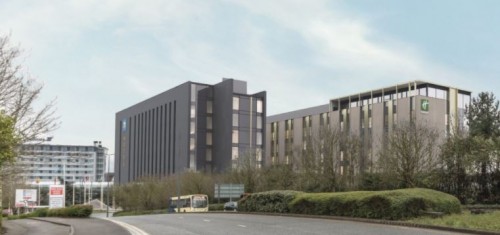
Rendering of proposed Hotel District being constructed at Airport City Manchester development project (image courtesy Airport City Manchester)
In addition to the above hotel properties, a new planning application has been submitted to Manchester City Council for a nine-story, 412-room hotel and restaurant, operated under the TRIBE brand, which is part of the Accor Group, whose other brands include Mercure, Sofitel and Novotel.
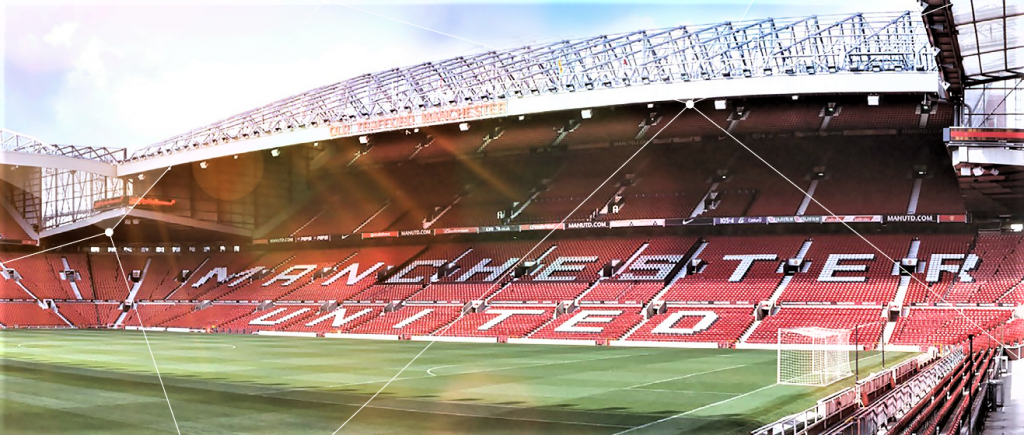
Old Trafford, the Manchester United football club statium, is just 20 minutes (about 10 miles) north of Airport City Manchester. Constructed in 1910 the stadium has undergone several expansions and renovations, its present capacity is 74,879.
Airport City Manchester’s joint venture partners will act as the developer of the $235 milion hotel district which will become home to the four new hotels by 2021, providing 1,171 new hotel rooms within the Airport City North footprint and supporting the creation of around 500 jobs.

